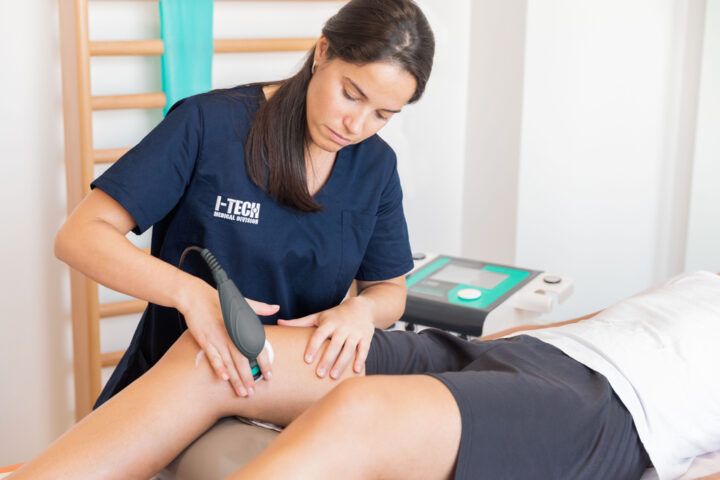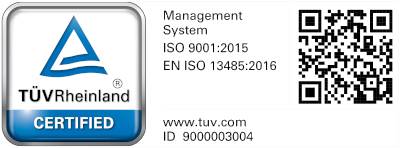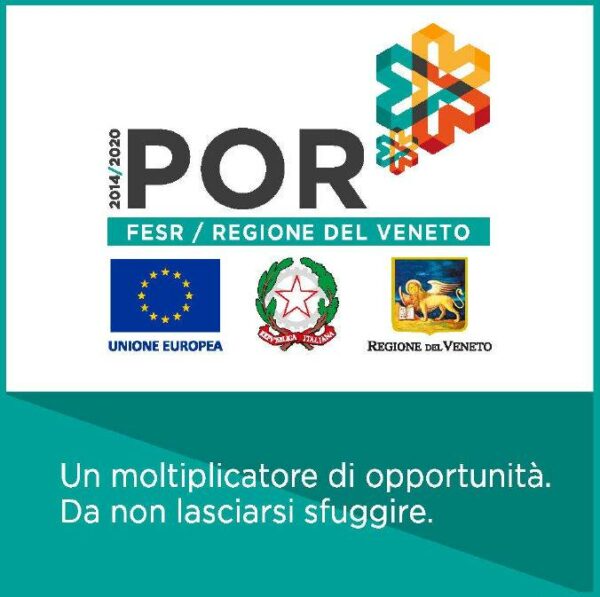- What’s tecar therapy?
- Diathermy and tecar: differences
- Tecar therapy: how it works
- Is tecar therapy effective?
- Capacitive and resistive mode: differences
- Thermal and athermic effects
- Acute and chronic treatments
- Diathermy vs. other physical therapies
- Laser therapy and tecar therapy: differences
- How a tecar therapy session takes place
- How long does a tecar therapy session last?
- Tecar therapy: after how long does it work?
- How much does a tecar therapy session cost?
- Physiotherapy and tecar
- Tecar therapy: for which areas of the body?
- For which pathologies do we recommend tecar therapy?
- Tecar therapy: the benefits
- Tecar therapy contraindications
- Side effects after tecar therapy
- Tecar therapy equipment
- What are the advantages of frequency modulation?
- Tecar therapy and costs
Are you a professional/physiotherapist and would like to deepen your knowledge on the subject?
Are you a diathermy expert and consider purchasing a new device?
Whatever stage you are at, be aware that you are in the right place.
It also applies to you, who do not know much about instrumental physical therapy, but looking for information on therapy because your doctor has prescribed tecar sessions.
Enjoy reading!
What is tecar therapy?
Diathermy, better known as Tecar therapy (an acronym for Capacitive and Resistive Energy Transfer), is a therapeutic technique that uses an electric current with frequencies in the MF (Medium Frequencies) radio band. It transfers energy in depth, through the tissues of the human body, triggering a biostimulating effect.
This is a therapy that is carried out in a medical practice, usually by a physiotherapist, on patients with a variety of pathologies, requiring rehabilitation, sports and also aesthetic treatment.
The very first applications of diathermy, limited to the development of endogenous heat, date back to 1939, when William Beaumont developed the first instrument capable of generating heat endogenously, thus coining the term “diathermy”. The name has Greek origins, literally meaning “heat through”.
Tecar therapy specifically, and diathermy in its broadest and technically correct sense, was patented in 1995. This year represents a milestone in the study and application of this technique in the therapeutic field.
Diathermy and Tecar - differences
As you may have noticed, we have used three different ways to refer to the same therapy. In fact, there is no difference between Diathermy, Tecar and Tecar therapy; they are generally used as synonyms. It is good to know, however, that the term diathermy denotes the therapeutic technique, while TECAR is nothing more than a commercial acronym derived from its main functions (it stands for Transferencia Electrica Capacitiva Resistiva, meaning Capacitive and Resistive Energy Transfer).
Tecar therapy: how it works
The physical principle on which diathermy is based is that of the capacitor.
The capacitor consists of two conductive armatures separated by an insulator and connected to an electric generator that creates a potential difference between the two plates.
This causes electrical charges to attract and repel each other concentrating near the two elements , increasing the density of positive charge in one plate and negative charge in the other.
In the case of a diathermy device, the armatures are represented by the handpiece (capacitive or resistive) and the return plate, while high-strength body tissue constitutes the insulation.
The current generator works in the long-wave radio frequency range and with a variable power in W.
In this way, there is no emission of external energy, but only a development of endogenous or internal energy at the level of the biological tissue, produced by the movement of ions and electrolytes, induced by the forces of attraction and repulsion generated between the two capacitor plates.
The ability to generate a current flow through an insulator, and to exploit tissues as focal elements of the therapeutic effect, is a differentiating feature of tecar therapy when compared with other techniques. Diathermy, in fact, is also extremely effective in depth, where other exogenous instrumental physical therapies lose their effectiveness.
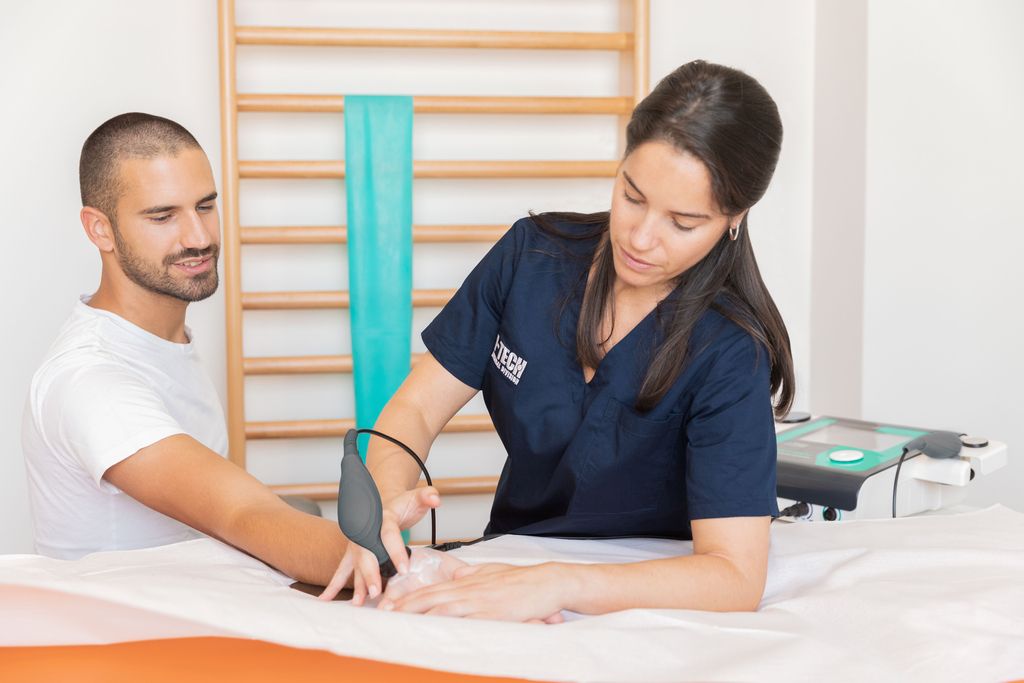
Is tecar therapy effective?
Now that we’ve defined the mechanism, you’re probably wondering: “Does tecar therapy work?”
With almost 30 years of history and thousands of clinical studies to support it, to date we can say that diathermy has excellent therapeutic effects. It is one of the most powerful physical therapies, as it is able to transfer more energy per unit of time to the human body.
Through the electromagnetic energy/tissue interaction, diathermy is able to produce a temperature increase that occurs in a uniform and controlled manner within the tissue.
This electromagnetic interaction results in the appearance of an ionic flux with a micro-hyperemia that favours the release of endogenous substances (especially cortisol and endorphins) that reduce pain, oedema and inflammation.
Diathermy, therefore, stimulates increased blood flow directly through increased temperature and indirectly through the demand for oxygen by the treated tissues. The increased blood supply boosts normal immune defences and stimulates tissue regeneration, shortening motor recovery times.
Treatment modes: differences between capacitive and resistive
Diathermy has two different treatment techniques:
• Resistive technique. In this mode, the concentration of charges, and thus the biological effect, occurs in the tissues with the highest resistance, which are interposed between the mobile electrode and the return plate.
Resistive contact transfer occurs by means of a non-isolated electrode that mobilises the charges so that they are concentrated in the areas of greatest depth and resistivity, i.e. in tissues such as bone, cartilage, tendons and deep muscles.
• Capacitive technique. With this mode, there will be an increase in charge density near the area below the mobile electrode and especially at the level of the superficial soft tissues (vascular and lymphatic circulatory system, adipose tissue and superficial muscles). Capacitive contact transfer is performed through an electrode treated with an insulating coating that mobilises ionic charges in the subcutaneous tissue.
Athermic and thermal treatment: differences
Although the term diathermy has a direct reference to its thermal effect, from the Greek “through” and ”heat”, to date we can state that this effect is not the only therapeutic mechanism of diathermy. It is indeed possible to do therapy even without triggering the thermogenic effect. In this case, we are talking about athermia. Le’s see the differences.
• The thermal effect is effective in reducing pain perception due to the effects that heat induces at the nociceptor level. It is indicated for most diseases, particularly chronic ones, since it also promotes peripheral vascularisation. This effect is easily managed by the operator, as [s]he adjusts the power.
• The athermic treatment, on the other hand, has the advantage that it does not trigger a high vascularisation, while maintaining the tissue biostimulation effect induced by the electric current. Thus, athermia is suitable for treating inflammation and trauma in an acute state, promoting the reduction of swelling – which would otherwise be impossible to achieve with hyperthermic treatment
More information?
Treatment of acute and chronic pathologies
From these few paragraphs, we have already been able to see how diathermy differs, positively, from other therapies: both because we are able to act in depth, and because we are able to guarantee a therapeutic effect in both acute and chronic conditions.
The athermic effect, in fact, is ideal to treat acute states . In sports, for example, it is possible to perform the first diathermy treatment as early as a few minutes after an injury, as in the case of a sprain. It is important to emphasise that in order to treat acute conditions, one must work in athermy, so as to avoid an aggravation of the inflammatory state and swelling.
In the treatment of chronic problems, however, the thermal effect is essential. In combination with the electromagnetic effect, it reduces pain and promotes peripheral and deep vascularisation, providing an important improvement in most chronic diseases.
In both treatments, a key aspect is patient compliance. With active collaboration and constant feedback on perceived heat level, the therapist will be able to deliver therapy even more effectively.
Difference between diathermy and other physical therapies
Diathermy is a unique therapy. However, it can be likened in some respects to magnetotherapy and laser therapy – in particular, in terms of the type of energy used.
The electromagnetic effect unites magnetotherapy and diathermy, although the latter differs markedly in terms of time; both in terms of obtaining results and the duration of the session itself.
In fact, magnetotherapy requires prolonged treatments, in the order of several hours per application. Visible results can be expected with at least 30 days of treatment.
Diathermy, on the other hand, is able to produce positive effects that can be easily perceived already within 1 or 2 sessions whose average duration is around 20-30 minutes.
Laser therapy and tecar therapy: differences
The diathermy-laser therapy symmetry is mainly represented by the thermal effect. In addition, the laser can also be used acutely and performs very quickly in certain cases.
So what is the difference between these two techniques? In the depths they are able to reach.
The laser uses a light of varying frequency and intensity as its energy source, which determines its penetration capacity. The therapeutic depth that can be reached with laser therapy is a few centimetres. Diathermy, on the other hand, manages to penetrate tissue down to the bone, thanks to the physical principle of the capacitor on which it is based and the ability of the high-frequency current not to encounter resistance in body tissue.
How a tecar therapy session takes place
As mentioned above, a diathermy session is carried out in a medical practice.
Generally, the patient is asked to lie on a couch, although thanks to special electrodes, it is possible to do therapy even while moving: the patient can perform specific dynamic actions under the therapist’s instructions, thus increasing the effectiveness of the treatment.
Diathermy is applied in contact with the skin. The practitioner positions the return plate and handpiece (capacitive or resistive) on the area to be treated and applies conductive cream. By using the correct geometry maximum results will be achieved. It is therefore advisable to wear clothing that can facilitate treatment in direct contact with the skin.
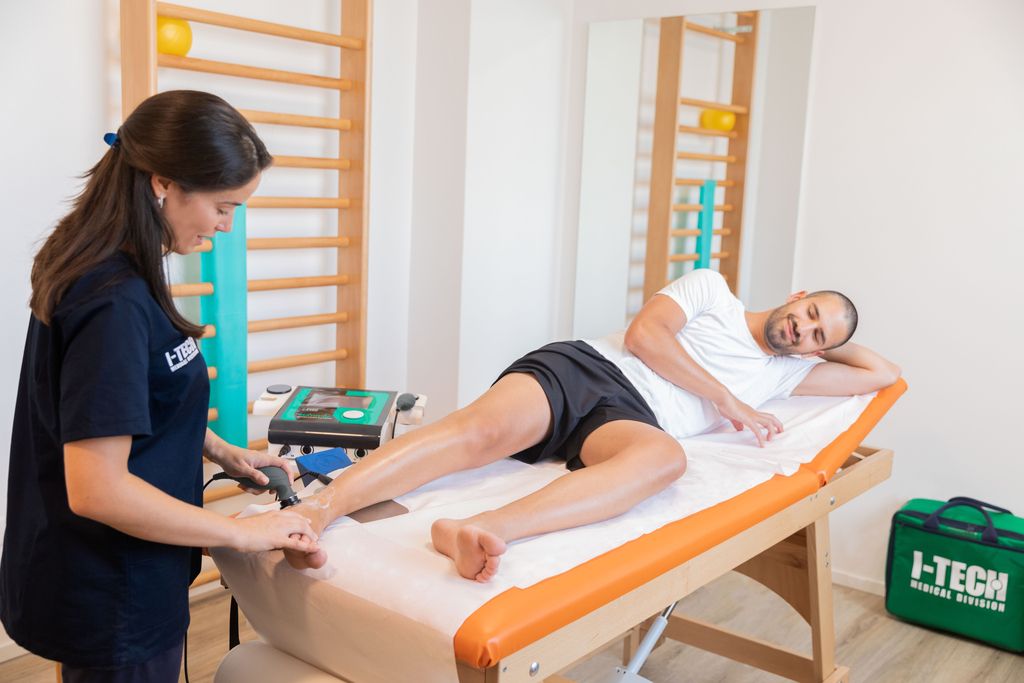
How long does a tecar therapy session last?
A diathermy session lasts an average of 20-25 minutes, depending on the body part and type of treatment. In fact, if the therapy is performed on small areas, the session will last less than 20 minutes; on the other hand, if the treatment is carried out in athermy , the session will last longer.
The diathermy session can be customised on the basis of the therapist’s manual treatment habits – since the handpieces can also be used as instruments for mechanical treatment.
Tecar therapy: after how long does it work?
A diathermy cycle usually lasts 10 sessions. Sessions are usually carried out two to three times a week. The first results can already be seen after the first treatment, although for obvious reasons they cannot remain stable for long. At least four to five sessions are required to achieve good, long-lasting results even in the days following the treatment.
How much does a tecar therapy session cost?
It is difficult to establish a single national price for a diathermy session as there are many variables to take into account: the duration of the treatment, the provision of other treatments in the same session, and finally the geographical location. However, we can give a rough indication: the average cost of a session can range from €25 to €50.
Physiotherapy and tecar
Diathermy is an extremely effective therapeutic technique that can make all the difference in a physiotherapy centre. When combined with other therapies, it can extend the benefits of treatment.
As an example, if a diathermy session is performed before a manual treatment, we will see how it will facilitate, in terms of time and effectiveness, the subsequent manual treatment. But how does it work?
Diathermy exerts a preparatory effect in the tissues that will undergo the following treatment. This advantage consists of an increase in local temperature, superficial and deep vascularisation, induced by both electromagnetic effects and hyperthermia, a reduction in basal muscle tone and a reduction in the viscosity of elastic muscle elements.
When treating pathologies requiring kinesiotherapy or rehabilitative physiotherapy, diathermy can be integrated both before and after the physical activity session.
If performed beforehand, diathermy can help, in the presence of joint problems, to increase mobility, reducing friction and improving the sliding of joint heads.
If performed afterwards, it is useful in muscle recovery. It promotes the active recovery mechanism by acting at both vascular and metabolic levels.
In the initial stages of a rehabilitation process for joint problems, on the other hand, the use of tecartherapy in athermic mode (at the joint level) promotes metabolic recovery processes and direct anti-inflammatory action at the level of joint structures.
More information?
Tecar therapy: for which areas of the body?
n general, diathermy can be applied to any part of the body, except for those forbidden to most physical therapies such as glandular areas, axillary cavity, pubis and genital organs, sternum, supraclavicular and subclavicular fossa, iliac crest, tibial crest.
The treatment of bony eminences is only possible with particular care in terms of both the technique used and the mode of operation due to the resistance of the bone to the passage of current, which leads to a sudden increase in temperature in the area.
Parts of the body subject to problems that can benefit most from a diathermy treatment are shoulder, elbow, hand, wrist, spine, cervical, back, lumbar, sacral, knee, ankle, foot.
For which pathologies do we recommend tecar therapy?
As mentioned above, diathermy is an effective technique for treating all types of pathology, acute, subacute and chronic. Among the main ones:
– tendinitis,
– tendinosis,
– joint pain,
– muscle contracture,
– muscle strain,
– bruise,
– epicondylitis,
– Golfer’s elbow,
– neck pain,
– low back pain,
– lumbosciatica,
– slipped disc,
– whiplash,
– gonarthrosis,
– chondropathy,
– distortion,
– ACL, LCL, MCL injuries.
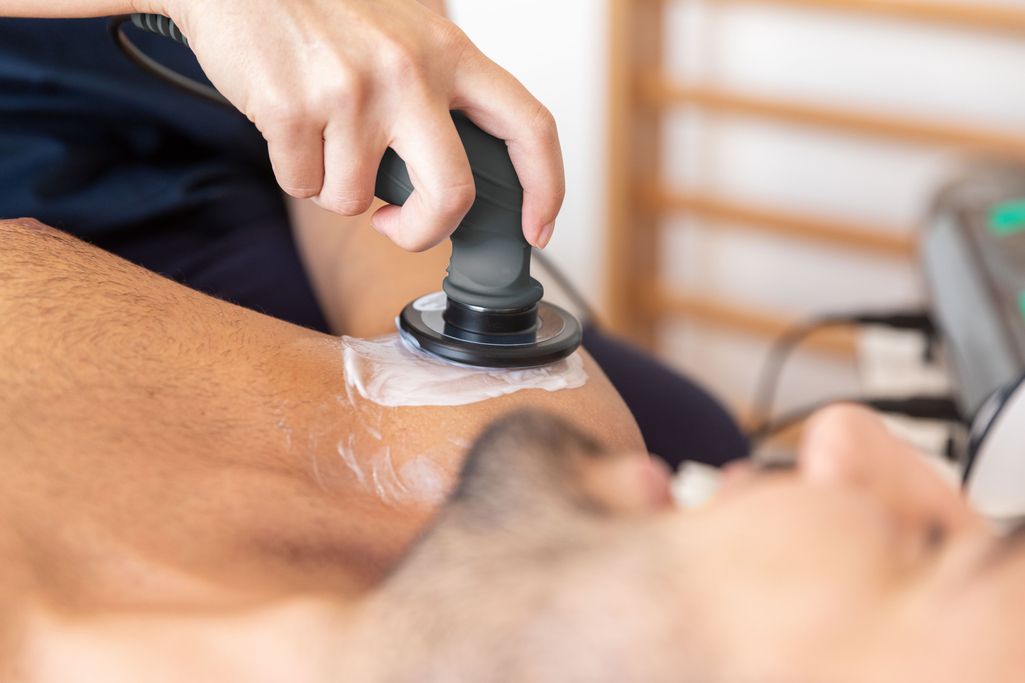
Tecar therapy: the benefits
We can summarise the benefits of diathermy in five main points:
1. Fast-onset analgesic effect
Related to biostimulation and the endogenous thermal component that reduces the ability to perceive and transmit pain.
2. Rapid and medium onset anti-inflammatory effect.
Biostimulation promotes endogenous healing processes.
3. Biostimulating effect
The supply of energy and micro-vascularisation (in athermia treatment) and deep vascularisation promote both healing processes and the supply of nutrients. They also promote the drainage of catabolites by normalising cellular biological processes.
4. Myorelaxant effect
The maximum effect is obtained in a moderately hyperthermic or hyperthermic treatment, which triggers a direct viscosity-reducing effect at the muscular level. It also promotes deep vascularisation and normalisation of biological processes.
5. Restores vascularization
It is mainly related to the endogenous hyperthermic effect. It elevates the blood flow in the treatment areas, increasing the volume of the available capillary bed, thus favouring the optimisation of endogenous metabolic processes.
Tecar therapy contraindications
As with any physical therapy, there are also warnings concerning the use of diathermy.
In fact, unless otherwise medically indicated, treatment could not be provided in cases of individuals with:
– bleeding;
– cancer;
– phlebitis, thrombi and arteriopathy;
– decreased sensitivity in the area to be treated;
– metal prostheses;
– pacemaker;
– hearing aids;
– insulin pumps;
– intrauterine devices;
– fever or infections;
– pregnancy;
– epilepsy;
– children under the age of 14.
Side effects after tecar therapy
In general, unwanted effects and contraindications are mainly related to the use of the device, and not so much to the nature of the therapy.
Some undesirable effects may be related to a worsening of the pain sensation after the session (either immediately after, or a few hours after the treatment), due to the use of a high electric voltage that induces a hyperthermic effect, either undesirable or excessive.
For this reason, especially if you are at the beginning of your experience with the instrument, it is advisable to carry out the first sessions in athermy or with moderate hyperthermia in order to avoid any side effects.
Tecar therapy equipment
Choosing a diathermy device is certainly not easy, both because of the type of technology used and the technical characteristics and equipment of the machine, and finally because of its price. The wide range of tecar devices on the market undoubtedly does not help when evaluating a tecar therapy machine.
We therefore thought we would help you in your choice by listing what we think you should consider:
• Multifrequency: allows you to customise the treatment, adapting the depth of action to the patient’s needs (state of health and progress of the pathology). The advantage of a multi-frequency device is precisely in choosing where the energy goes, for greater effect. As you know, with high frequencies you work on the surface, while with low frequencies you work in depth. It therefore becomes an important feature, in some respects even more than the power itself.
• Treatment protocols: a real guide to treatment, especially if you are taking your first steps into the world of diathermy.
• Available accessories: to ensure you have every treatment option.
• Method of operation: thermal, athermic.
• CE medical device: essential to ensure reliability and safety of treatment.
• Training: essential to optimise results and make maximum use of the device. Even better if customised!
Other aspects that we recommend you consider are: the power (real, regardless of the type of patient), the ease of cleaning the electrodes between sessions, the possibility of using the device continuously (avoiding cooling periods) and the size/weight of the machine (a light and transportable device allows you to do therapy outside your practice).
It is clear that the choice is also guided by other factors, including: the needs of the individual therapist, one’s own preferences, and of course also the available budget. What we suggest you do is to lay bare the devices you identify, so that you can make a more objective choice about the potential of the individual product and avoid being influenced by secondary information, which is often communicated to differentiate the product from the competition. Always bear in mind that the operating principle is the same in all machines. 😊
Here, then, is how we think we can help you in your decision-making process, by presenting our professional diathermy devices.
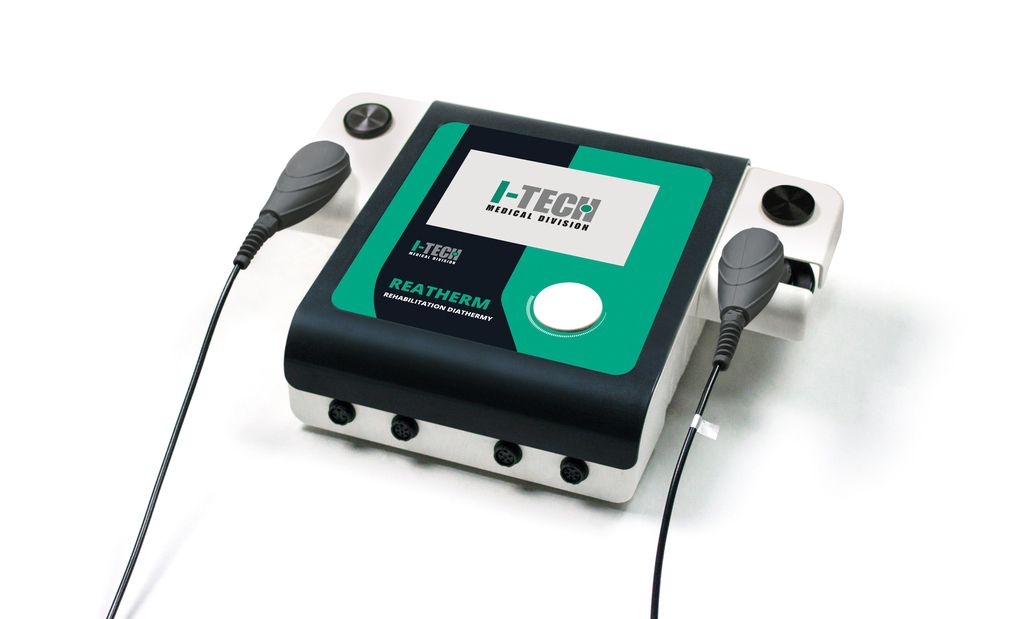
401 frequencies (300÷700 kHz)
Frequency modulation (1÷100 Hz)
Atermia
50 preset programmes
(35 Rehab, 10 Sport, 5 Beauty)
10 Free Memories
CUSTOM mode
Programmable treatment time up to 60 minutes
Real power
200 W
Dimensions (bxhxd) and weight:
27x12x30.5cm
3 kg
7″ colour display
The equipment includes:
Resistive and capacitive handpiece
Capacitive and resistive electrode kit
35 and 60 mm Ø
Bipolar handpiece 50 mm Ø
Return plate
Conductive cream
Transport bag
Customised training
on devices and treatments by professionals, experts in the field
Medical device CE 0068
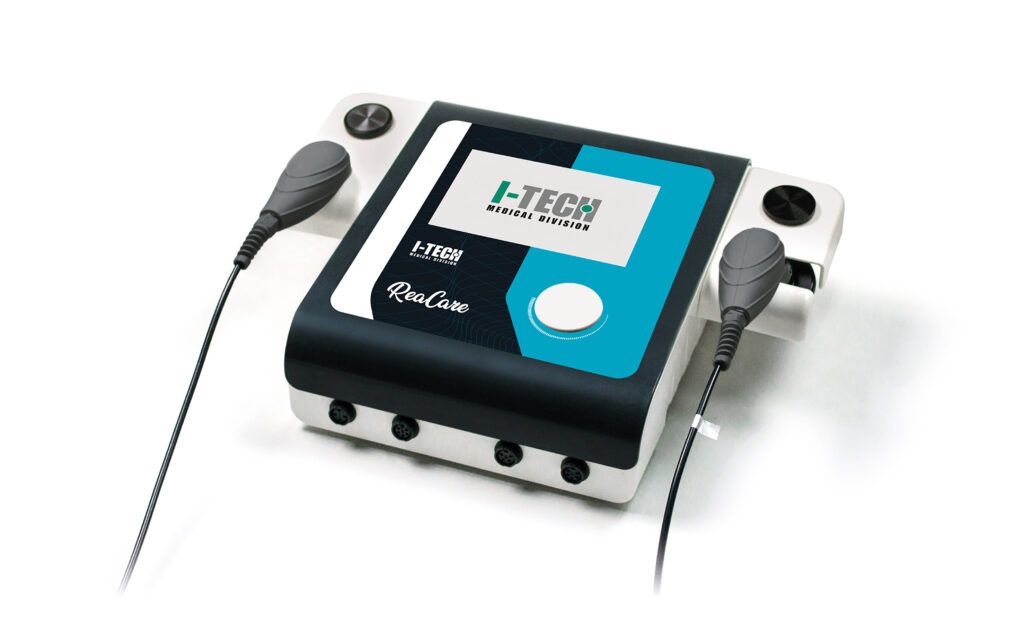
201 frequenze (400÷600 kHz)
Modulazione di frequenza (1÷100 Hz)
Atermia
34 programmi preimpostati
(24 Rehab, 10 Sport)
10 Free Memories
10 Free Memories
Programmable treatment time up to 60 minutes
Real power
160 W
Dimensions (bxhxd) and weight:
27x12x30.5cm
3 kg
Display a colori 7”
The equipment includes:
Resistive and capacitive handpiece
Capacitive and resistive electrode kit
35 and 60 mm Ø
–
Return plate
Conductive cream
Transport bag
Customised training
on devices and treatments by professionals, experts in the field
Medical device CE 0068
What are the advantages of frequency modulation?
This technique makes it possible to deliver energy to the patient in a non-uniform manner while ensuring therapeutic intervals at reduced intensities. In this way, it is also possible to comfortably treat those cases of increased sensitivity to therapy, comparable to the traditional athermic effect. Not to be confused, however, with the common duty cycle!
Frequency modulation is also a key aspect when using low frequencies. In fact, with frequencies between 300-350 kHz and a high modulation (100 Hz) we can achieve the so-called neuromodulatory effect. This treatment modality allows us to treat muscle and nerve at the same time, reducing pain from the very first session. The neuromodulation effect is most effective in the treatment of chronic diseases, whether neuropathic, somatic or psychogenic in origin.
Tecar therapy and costs
We close this article with some information on the costs of tecar therapy.
As mentioned earlier, diathermy devices are for professional use and feature advanced technology. The price for a good machine can range from €5,000 to €30,000, depending on its features. For a mini-guide on how to choose your device, please read the previous paragraph!


